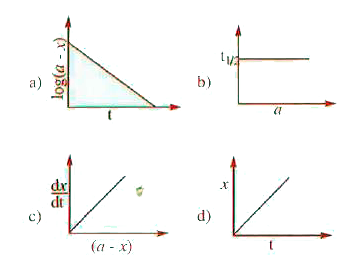Write the equation relating [R],[R]0 and reaction time 't' for a zero order reaction. [R]= concentration of reactant at time 't' and [R]0= initial concentration of reactiant. Solution in Telugu
Zero order reaction Rate constant k=[R]0−[R]t
2NH3(g)Pt−−−→1130KN2(g)+3H2(g)
Rate =k[NH3]0=k
∴ΔxΔt=k⇒Δx=Δt×k
Topper's Solved these Questions
- BOOK - VIKRAM PUBLICATION ( ANDHRA PUBLICATION)CHAPTER - ELECTROCHEMISTRY & CHEMICAL KINETICSEXERCISE - SHORT ANSWER QUESTIONS25videos
ELECTROCHEMISTRY & CHEMICAL KINETICS
- BOOK - VIKRAM PUBLICATION ( ANDHRA PUBLICATION)CHAPTER - ELECTROCHEMISTRY & CHEMICAL KINETICSEXERCISE - LONG ANSWER QUESTIONS12videos
ELECTROCHEMISTRY & CHEMICAL KINETICS
- BOOK - VIKRAM PUBLICATION ( ANDHRA PUBLICATION)CHAPTER - ELECTROCHEMISTRY & CHEMICAL KINETICSEXERCISE - PROBLEMS55videos
ELECTROCHEMISTRY & CHEMICAL KINETICS
- BOOK - VIKRAM PUBLICATION ( ANDHRA PUBLICATION)CHAPTER - D AND F- BLOCK ELEMENTS AND CO-ORDINATION COMPOUNDS EXERCISE - INTEXT QUESTIONS33videos
D AND F- BLOCK ELEMENTS AND CO-ORDINATION COMPOUNDS
- BOOK - VIKRAM PUBLICATION ( ANDHRA PUBLICATION)CHAPTER - GENERAL PRINCIPLES OF MMETALLURGYEXERCISE - DAM SURE SAQ1videos
GENERAL PRINCIPLES OF MMETALLURGY
Similar Questions
What are galvanic cells ? Explain the woriking of a galvanic cell with a neat sketch taking Denicell cell as example.
02:12View SolutionWhat are electro chemical cells ? How are they constructed ? Explain the working of the different types of galvanic cells ?
View SolutionThe standard potentials of some electrodes are as follows. Arrange the metals in an increasing order of their reductiong power.
1)K+/K=−2.93V 2)Ag+/Ag=0.80V 3)Cu2+/Cu=0.34V
4)Mg2+/Mg=−2.37V 5)Cr3+/Cr=−0.74C 6)Fe+/Fe=−0.44V01:03View SolutionSilver atom has completely filled d-orbitals (4d10) in its ground state. How can you say that it is a transition element ?
05:31View SolutionGive examples to differentiate roasting and calcination.
02:26View Solution[r]= concentration of reactant and t be the time Identify the order is correct option for order-
05:25View SolutionFor a first order reaction R→P, the rate constant is k. if the initial concentration of R is [R0], the concentration of R at any time 't' is given by the expression-
03:08View SolutionDrawn the graph that the concentration 'R', of the reactant and 't' the reaction time for a zero Order reaction.
01:49View SolutionFor a zero order reaction, the initial concentration of the reactant =[A]0 and after time 't' from the initiation of the reaction, the concentration =[A] . What will be the nature of the graph of '[A]' vs 't,
02:24View SolutionFor a zero order reaction '[R]0 is the initial concentration
04:49View SolutionWhich of the following graphs represent a first order reaction (a=initial concentration of reactant, x=concentration of reactant consumed, t=time)
 01:34View Solution
01:34View SolutionFor a chemical reaction R to P, the variation in the concentration (R) vs time (t) plot is given : Predict the order of reaction.
02:07View SolutionThe rate equation for a first order reaction is given by [R] = [R]_(0) e^(-kt) . A straight line with positive slope is obained by plotting [R]_(0) = initial concentration of reactant, [R] = concentration of reactant at time, t
02:00View SolutionC_(o) =initial concentration of the reactant C_(t) = concentration of the reactant at time t, k=rate constant of the reaction. Then the equation applicable for a first order reaction is
05:28View SolutionThe concentration of "R" in the reaction R→P was measured as a function of time and the following data is obtained [[R]1098.17.29t( minutes )0.0102030]
Order of the reaction isView Solution

